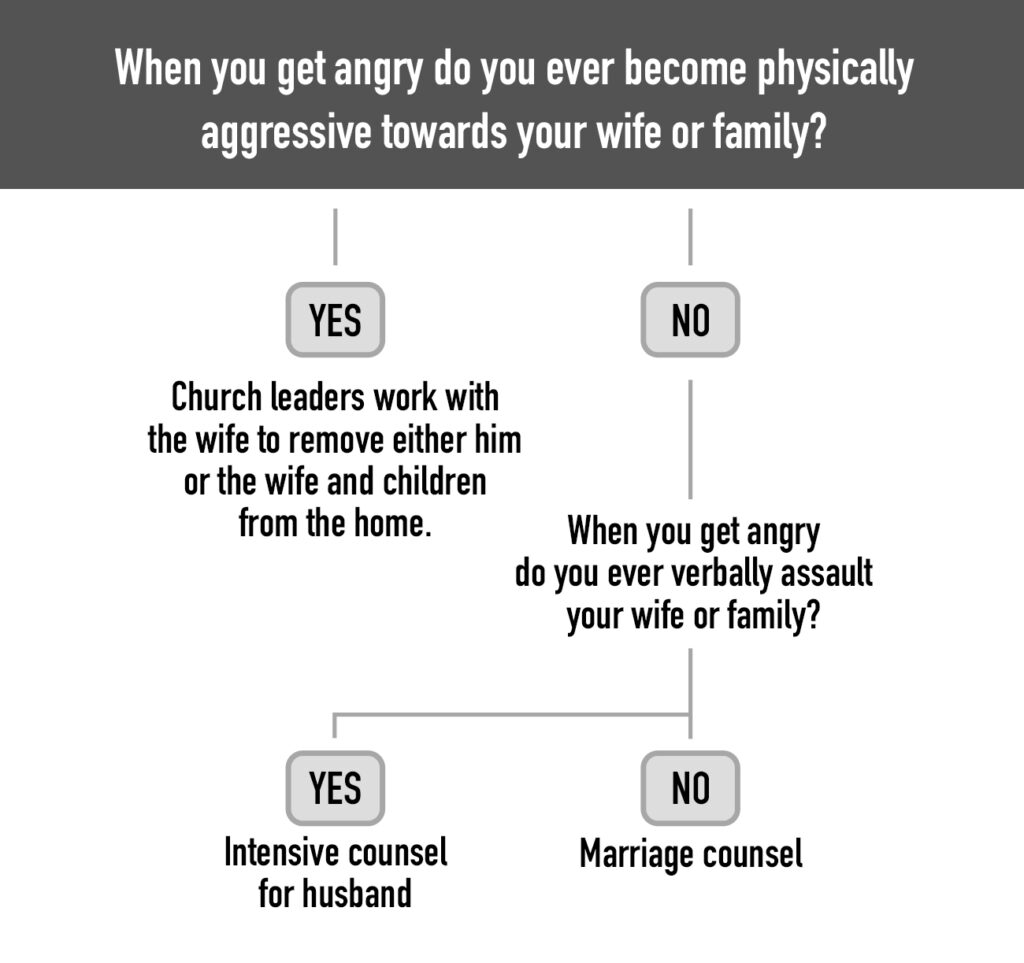A few years ago my favorite[1] professor at RTS Charlotte wrote a book called What’s your Worldview? In it, he used an interactive method similar to the Choose Your Own Adventure (CYOA) children’s gamebook series. It invited the reader to “make key decisions or choices at a number of points in order to determine the outcome.”[2] It was quite genius actually—not at all surprising because my professor is a GENUIS. But what I found fascinating about this method is that I think I’ve witnessed something similar in the counsel of domestic abusers.
In my last post, The Shape of Oppression, I mentioned that the church has been “overly focused on the man’s behavior in cases of abuse.” To further clarify, when counselors focus on the husband’s behavior in the home without considering the environment, we can unwittingly fall into the abuser’s net. That is; he wants to manipulate the outcome of his counsel and, by making key decisions to direct our attention to what he does rather than what he thinks, he successfully controls his counselor and what they counsel.
Just imagine a scenario where a husband is accused of coercive control. Counselors and pastors don’t want to leave a wife and family in harm’s way, however they also don’t want to wrongly indict the man. Serious charges have significant consequences. So, they approach each situation wisely and carefully (Pr. 18:17), asking thoughtful and probing questions about the husband’s behavior. Depending on those answers, counsel is directed toward the next course of action. Watch the (CYOA) progression using a representative ‘abuse’ inquiry.
“The Anger Question” [3]

Now, of course this is a simplistic example. Wise counselors listen carefully and work diligently toward finding out the motivation behind the husband’s behavior. However, there are several problems that an examination of behavior (including the heart behind the behavior) creates for counsel.
The Agenda Problem
Many of us are familiar with personality tests and spiritual gift inventories. If you’ve ever taken one of these assessments you know that the information you enter determines the results. Depending on your mood or desires when you take it, the outcome shifts to your preferred agenda. The same is true with behavior assessments in abuse counsel. The husband will answer questions about his behavior according to what he thinks the counselor wants to hear or how he wants the counseling relationship to flow. Ultimately, this process sets the stage for “the checklist.”
The Checklist Problem
A behavior checklist is a desired outcome of the abuser. Checklists have the tendency to provide the abuser with ‘proof’ that he desires to change. Checklists offer the abuser (literally) the least he can do. He will even adjust his behaviors at home to show his willing compliance with church leadership. Checklists can also be used as a competition. If the abuser is quicker at checking off behavior adjustments on his list, he can prove to the counselor that he is the one who desires to reconcile the marriage. He can instead turn the attention toward the “real problem” in the home (aka his wife).
The Continuum Problem
Addressing the perpetrator at the behavior level requires assigning his conduct on a continuum. For example, was he acting in anger? Or was it a murderous rage? Did he act in ways that were unconscionable? Or was he just acting foolish? Does his behavior fall somewhere in between? Depending on where we locate his behavior, we may over or under evaluate the severity of the situation. Other questions result as well, such as; who sets the standards on the continuum? Who does the evaluating? What happens when the wife’s experience differs from the evaluation?
The Causation Problem
As a domestic abuse advocate I am frequently asked, “when does the husband’s behavior cross the line into abuse?” My answer is that there is no line. An abuser’s behavior is abusive.[4]
Husbands don’t suddenly become abusers. They don’t simply drift over into the dark side.
Let me explain. All marriages struggle as a result of the Fall; marriage includes two sinful partners. However, in a relationship where there is no abuse, the spouses are committed to resolving conflict and restoring unity. This mindset originates from a Christian worldview that shapes their thinking (and subsequently their behavior) of marriage as a loving, serving, and sacrificial commitment to God and one another.
In abusive marriages, the abuser does not have that same worldview. His worldview, like all worldviews, shapes what he believes, how he interprets experiences, how he behaves in response to those experiences, and how he relates to others.[5] But for the abuser, the shape of that world is him. So, all of his words, gestures, and attitudes (or worse) are intended to emotionally, spiritually and/or physically control his wife’s thinking and behavior. Whatever he does is meant to shape her heart and mind primarily toward him; his wants, his desires, his needs. His aim is to make himself supreme “on the throne of his own selfhood.”[6]
Therefore, in his kingdom,[7] all of his behavior is evil.[8] These are men who do not have a heart for Christ.[9] The counseling outcome must be focused less on changing the behavior and more on knocking pseudo kings off of their self-made thrones. “Only when he has restored his stolen throne to God are his works acceptable.”[10] God must plant a new principle in the husband, so that his subsequent behavior will spring out of a desire to promote the honor of God and the good of his bride.[11]
[1] I had several ‘favorite’s’. Let’s keep this one a secret, shall we?
[2] James N. Anderson, What’s Your Worldview? An Interactive Approach to Life’s Big Questions (Wheaton, IL: Crossway, 2014), Kindle Version Location, 130.
[3] The wife is the expert as to whether or not her safety would be further compromised in this situation and MUST be consulted. A safety plan must also be in place before any action is taken. Check your state’s law regarding mandatory reporting in cases of domestic abuse.
[4] I am not declaring that he cannot change (Romans 1:16).
[5] Worldview, 159.
[6] A.W. Tozer, The Knowledge of the Holy (New York, NY: Harper-Collins Publishers, 1961), 29.
[7] Ibid, 30.
[8] Romans 3:10-12; Psalm 14:1-3; 53:1-3.
[9] Ann Maree Goudzwaard, “Help Her; Developing a Churchwide Response for Vulnerable Women” in, Beyond the Roles: A Biblical Foundation for Women and Ministry, General Editor, Melanie Cogdill (Lawrenceville, GA: CDM Discipleship Ministries, 2019), 131.
[10] Tozer, Knowledge, 30.
[11] Ibid, 31.


